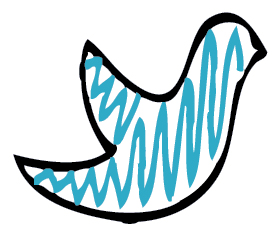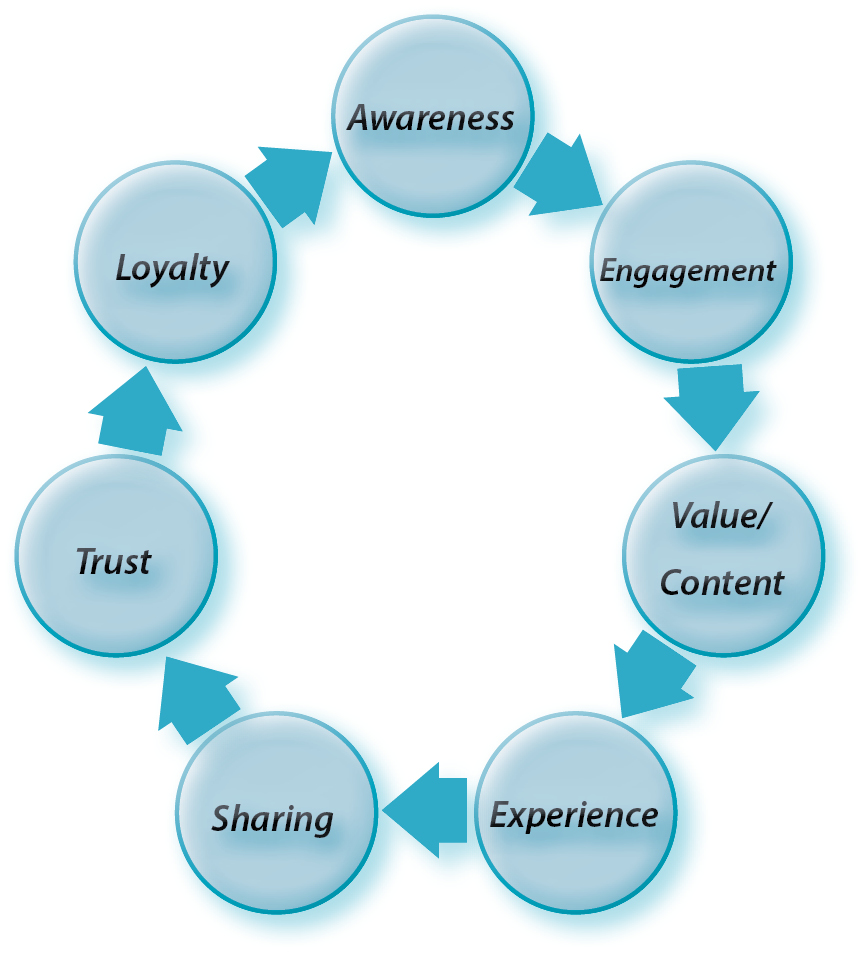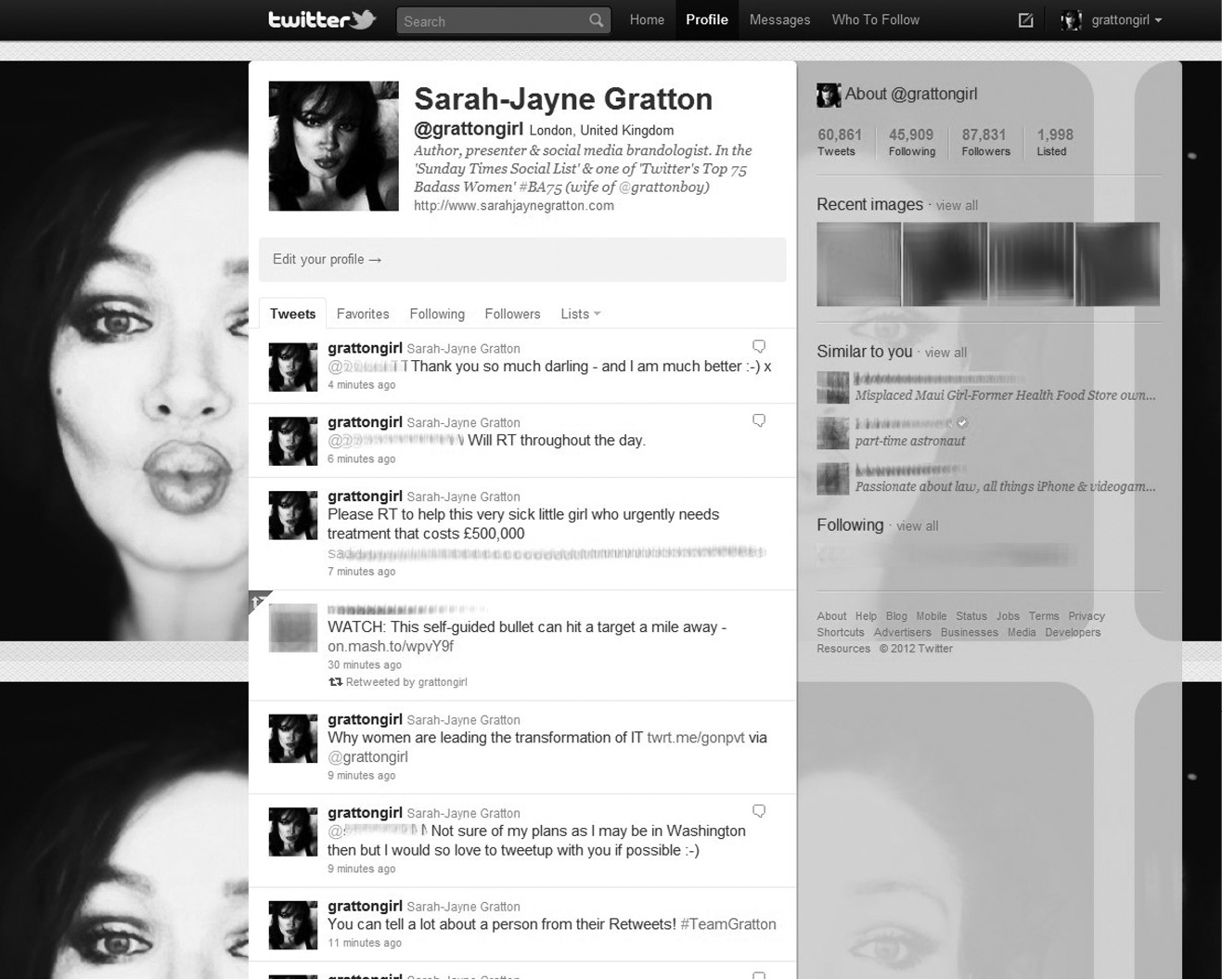Introduction
The Rise of the Personal
“It’s all become very personal indeed.”
@grattongirl

It wasn’t a sudden change. It didn’t occur in a single earth-shattering moment of realization and there were certainly no anatomical transformations. But the change came: a gradual, distilling of that all-important bottom line with my own unique blend of self, resulting in a concoction so headily steeped in engagement that it became socially intoxicating.
And where did it all begin?
Like part of a dying herd of corporate cattle, I am one of many who escaped the heat of the traditional branding iron and transformed my business message into something personal — something me! The irony lies in the fact that this evolution came about as a result of a communications curfew to the tune of 140 characters. Suddenly, ‘less’ was the new ‘more’ and my personal polarities became fundamental to the way that my business communicated itself.
You see, what’s happened is that Twitter has become far more than just the micro-blogging service initially intended. Even Jack Dorsey, its founder, couldn’t have envisioned just how extraordinary the outcome of that initial team meeting over Mexican takeout in the park on that fateful afternoon would prove to be.
After all, Twitter has not only tuned into the way marketing has changed from a monolog to a two-way conversation-based system, it has been instrumental in its evolution. It’s personalities, not pitches, that sell today. And it’s not what you have to say to others that make your brand successful, it’s what others have to say about you.
For smaller businesses and entrepreneurs, the shift has provided previously untold opportunities to compete with the big boys in their respective business arenas. And, as for the big boys themselves, it’s been nothing short of a wake-up call. A time to put away the foghorn and start listening instead, as creativity rather than cash-flow takes the reins of brand adoption, while relationships and engagement become the new currency. It’s all become very personal indeed.
In a 2011 Pivot survey done with the Hudson Group, it was discovered that 97 percent of businesses believed their brands would be “lifted” through social engagement, yet fewer than 40 percent had used the social sphere to determine what their evolved customer base actually wanted. Maybe they just weren’t listening or maybe they were afraid to face facts, but the old-school methods and theories of marketing, the ones that many of the biggest brand names had cut their teeth on, are now archaic and rather sad. Call it the fear of the unknown, call it a security blanket. Whatever you call it, it’s completely understandable. But understandable actions don’t always move us forward; instead, they all too often keep us hovering in an abyss of uncertainty.
Immediacy and the Rise of the Social Consumer
In the brave new world of Twitter, the rise of the social consumer can no longer be ignored. I have personally cast asunder much of the traditional form of press in favor of trusted online resources to provide the news and information I crave each day and that, in turn, I share with my followers. My Twitter streams are carefully sectioned and categorized according to my wants and interests, and I no longer rely on third-party aggregated media sources to ascertain what’s going on.
Moreover, a growing number of celebrities and high-profile personal brands have found that Twitter has handed them the keys to their old-media shackles, as more and more choose to use the platform to share the news and photos that keep them in the public eye through their daily tweets, without the need to rely solely on traditional press and paparazzi routes.
This new approach, however, can prove to be a double-edged sword — the phrase “once tweeted, never forgotten” springs to mind. The immediacy of Twitter means that once it’s out there, it’s out there for good, a fact that many have learned the hard way.
The role of the modern successful brand is an enabling one, one that listens and responds to the voice of its audience through engagement and empathy. If your brand provides value to the social consumer, it will become trusted and your social audience will over time become your brand ambassadors. It’s a trust cycle (see Figure A-1) that, if adopted correctly, will gain momentum and can lift the smallest personal brand to dizzying heights of success.
So what’s happening? We’re living in a relationship-based social ecosystem that has finally found its voice. Today’s consumer has more power than ever and, no matter what size your brand may be, you need to accept and embrace that truth if you’re to survive and thrive.
Figure A-1
A trust cycle

A Cautionary Tale
This brings me to damage limitation, something that I cover later in the book, but for now I want to focus on a single, incredibly profound case.
In January 2012, Minhee Cho (@mintymin) went into a Papa John’s (@papajohns) pizza restaurant in New York for takeout. What she received that day was far more than just a pizza, however: It was a wake-up call into just how powerful her social voice was. Upon checking her receipt, she noticed that they had printed her name as “lady chinky eyes” (as shown in Figure A-2).
At first, Minhee was upset by the clearly racist remark, but then she got angry and decided to share her experience with her Twitter followers by tweeting a photo of the receipt for all to see. It’s worth mentioning here that @mintymin didn’t have a huge following at that time — only a couple of thousand followers, in fact — but that fact is what makes this example even more powerful.
Within minutes, hundreds of outraged tweets began flooding in, each mentioning @papajohn, @mintymin, and the appalling customer service she had received. Her original tweet was retweeted over and over and was viewed by more than 250,000 people on Twitter within a week of it first being tweeted. That represented both a phenomenal consumer result and a phenomenal blow for Papa John’s, which then spent weeks of work on damage limitation: investigating the outcry, firing the employee, and tweeting apologies. It was certainly a wake-up call for the company that now knew the full power of what Twitter can achieve in brand awareness — good and bad — and should be remembered as a cautionary tale for businesses that dare to take the power of the social consumer lightly.
Figure A-2
Minhee Cho’s receipt from Papa John’s, which set off a storm of protest via Twitter and showed the power of Twitter on brands

Emotions and Relationship Rituals
The psychology of a personal brand begins and ends with emotions. It’s what shapes our view of the world and how we experience our lives within it. The brands we grew up with form an emotional allegiance within us, and their logos act as triggers to moments and events that have shaped our lives. For me, the Heinz logo conjures up images of fireside suppers as a child: my grandmother humming in the kitchen as she happily stirred the pot of Heinz cream of tomato soup (my all-time favorite) while the wonderful aroma, combined with that of hot buttered toast, teased my taste buds and filled me with a deep sense of belonging and security.
My devotion to the brand has since been passed down to my daughter, who now finds immense comfort in her soup-and-toast supper rituals, where nothing other than the Heinz brand will do.
Another highly emotional brand is the phenomenon of Apple. Lovers of the brand are nothing short of fanatical about its products, content to queue for hours to purchase each latest offering the brand creates. Later in the book, I explore how Twitter has remodeled branding using relationship rituals that create an emotional bond between the person and the brand.
So what are these relationship rituals? They center on our need to feel connected to something other than ourselves, to feel that we are important and that our voices will be heard. Twitter came along at exactly the right time. Uncertainty was rife, economies were collapsing, and life felt a little more fragile. Suddenly, we found a way to reach out through the uncertainty, to share and to empathize, to bond and to build. Through Twitter, our online relationships became very personal as we entered a new frontier of communication.
This new frontier provides opportunities that were previously much harder, if not impossible, to obtain: the ability to listen to hundreds of conversations about our brands in real time. Consumers are online all day, every day, sharing and tweeting away about how they feel. Sentiment is oozing out of every tweet, and we should not fear it. Instead, we should embrace it as the new lifeblood of branding. The ability to listen and understand how consumers feel (whether good or bad), what is important to them, and what their expectations are provides huge opportunities for forming the emotional allegiances needed for enduring brand loyalty.
But having explained the emotional underbelly of social media and the rise of the social consumer isn’t enough in itself to make your brand successful. So, in this book we’re going to take a long journey together to uncover the secrets that will let you go beyond your preconceptions of broadcasting and marketing to build a successful and — yes, I’m saying it — profitable brand through Twitter. After all, you want to communicate with your consumers, understand what they want, and view your offerings from their perspective.
But first you have to learn to identify what tickles their emotions, what gets the conversation going, and what makes them respond with conviction and passion.
Unlike Heinz and those other brands of yesteryear, today’s brands can’t hide behind their logos. Nowadays, consumers want to know who they are. They don’t want to talk to a faceless, nameless entity; they want to sense the person behind it — the personal. They want to like and get to know you, not just interact with your business. Having a friendly, smiling face in your Twitter profile is definitely more personal than just a logo. In essence, social media has dissolved the walls that existed between the consumer and the brand and has provided the opportunity for one-on-one connection in a way never before possible.
It’s time to stop thinking of business as something cold, functional, and without a heartbeat. After all the very essence of business is the fulfilling of needs — a very personal and heartfelt thing, indeed. Once you fully grasp this concept, trust me, that proverbial lightbulb will turn on — and it will all make sense. It doesn’t matter what your core business is — I’m not telling you what you should and shouldn’t be selling,; you’re smart enough to have figured that part out already. It’s the doing that’s drawn you to open these pages — the how and why and what’s next of it all.
In a way, it’s like show business! That first tweet is tantamount to that first opening performance. You’ve listened to the other acts perform, you’ve heard the audience’s response, and now it’s your turn. That all-important first tweet can be as nerve-wracking as a soliloquy.
Every morning my Twitter audience tune into my personal show. I comment on tweets I received and always retweet posts of interest that my audience has provided, along with my own comments. I suggest links that my audience may find interesting and, above all, I entertain them and keep them coming back for more. The @grattongirl brand has become something that thousands have bonded with and feel connected to (see Figure A-3). As a result, my revenue streams have flourished, and both my pockets and my heart are full. I couldn’t possibly have achieved this level of success using traditional forms of marketing — and neither can you.
Figure A-3
Thousands feel connected to the @grattongirl brand.

I’m here to reveal how to create a brand that hits the ground running and how to evolve an existing brand into one that touches the hearts and lives of others.
And I’m not exaggerating! Remember that emotions are everything — they always have been and they always will be. Without them, we cease to be human and we cease to invest in the human race.
Read on, and remember that your journey starts here.

